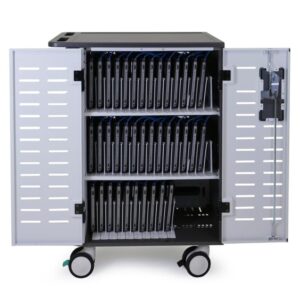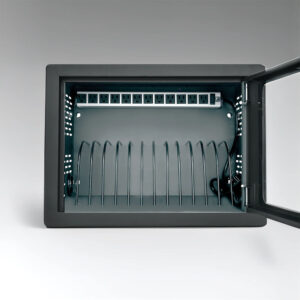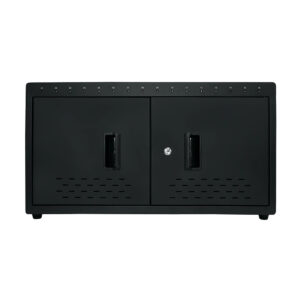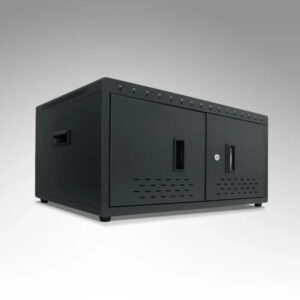Summary
As educational institutions increasingly incorporate digital technology into the classroom, the need for effective device management has become paramount. Schools are investing in charging cabinets, also known as charging lockers, to ensure that students’ laptops, tablets, and other devices are consistently charged and organized. This investment addresses a growing challenge as more schools adopt one-to-one technology programs, with 84% of elementary schools and 90% of middle and high schools in the United States now employing such initiatives. Charging cabinets not only provide secure storage and charging solutions but also enhance classroom organization and student accountability, facilitating a more focused and effective learning environment.
The integration of charging cabinets is driven by several key factors, including the need for efficient device management, enhanced learning participation, and cost-effectiveness. With an increasing number of educators relying on technology for daily classroom activities—59% requiring devices three to five times per week—schools recognize that charged devices contribute significantly to student engagement and academic success. However, the reliance on technology is not without its controversies; some educators report challenges related to device misuse and the financial implications of maintaining such infrastructure, leading to ongoing debates about the best approaches to implement these solutions effectively.
Furthermore, charging cabinets offer benefits beyond merely keeping devices powered. They promote accountability among students, reduce clutter in the classroom, and can be integrated into school security systems for added protection. As schools continue to navigate the complexities of modern education, the investment in charging solutions stands as a critical component in ensuring that technology serves its intended purpose: enhancing learning outcomes and supporting students’ educational journeys.
Overall, as the educational landscape evolves with advancing technology, the role of charging cabinets in schools is expected to grow, shaping how institutions manage their resources and support their students’ technological needs.
Table of Contents
Background
As technology becomes a cornerstone of modern education, schools are increasingly integrating digital tools such as laptops, tablets, and smartboards into the classroom environment. This shift has led to dynamic and interactive learning experiences, fostering collaboration, creativity, and critical thinking among students. However, with the widespread adoption of these technologies arises a significant challenge: ensuring that devices remain charged, organized, and ready for use at all times. This necessity has given rise to the use of charging carts and cabinets, which play a crucial role in supporting tech-driven education.
The need for effective device management has become apparent, particularly as educational institutions adopt one-to-one device programs. According to recent studies, 84% of elementary schools and 90% of middle and high schools in the United States have implemented such programs, indicating a strong reliance on devices for daily learning activities. Furthermore, a survey found that 59% of teachers require devices for classroom activities three to five times per week, underscoring the importance of having functioning technology readily available. Unfortunately, a significant portion of educators—about 40%—reported being deterred from using portable devices due to limited access to power, highlighting the critical role that charging solutions play in the educational landscape.
To address these challenges, schools are increasingly investing in charging cabinets and carts, which help to mitigate issues related to uncharged devices and chaotic charging environments. These solutions not only organize the devices but also ensure that they are safely stored and charged, allowing educators and students to focus on learning rather than logistical concerns. As the prevalence of technology in classrooms continues to rise, so too does the importance of robust charging infrastructure, which is essential for maximizing the benefits of digital education.
Charging Cabinets
Charging cabinets, also known as charging lockers, have emerged as essential tools in modern educational environments, playing a crucial role in maintaining an organized classroom. By providing designated storage spaces for each device, these cabinets help reduce clutter, allowing students to easily locate and store their gadgets. Additionally, the secure nature of charging lockers enables devices to be charged overnight without concern, ensuring they are fully powered for the next day.

Benefits of Charging Cabinets
The integration of charging cabinets offers numerous benefits to schools. Firstly, they enhance classroom organization by keeping devices stored and charged in a centralized location, minimizing the time students spend searching for their gadgets. Furthermore, charging lockers can be incorporated into school security systems, featuring digital locks that utilize personal identification numbers (PINs) or biometric authentication. This level of security not only protects valuable technological investments but also instills confidence in students and staff regarding the safety of their devices.
Moreover, charging cabinets promote accountability among students, as they are responsible for their devices and the condition in which they are stored. This fosters a sense of ownership and responsibility, essential skills in the educational development of students.
Implementation in Schools
Schools are increasingly recognizing the necessity of integrating charging solutions such as cabinets and carts into their infrastructure. These solutions can be tailored to various educational environments, from mobile computer labs to traditional classrooms, thereby accommodating the diverse needs of students and educators alike. Charging carts, for instance, are designed with mobility in mind, featuring wheels for easy transport between different rooms or departments. This flexibility is particularly beneficial in settings where devices are shared across multiple areas, ensuring that students have access to fully charged equipment whenever needed.
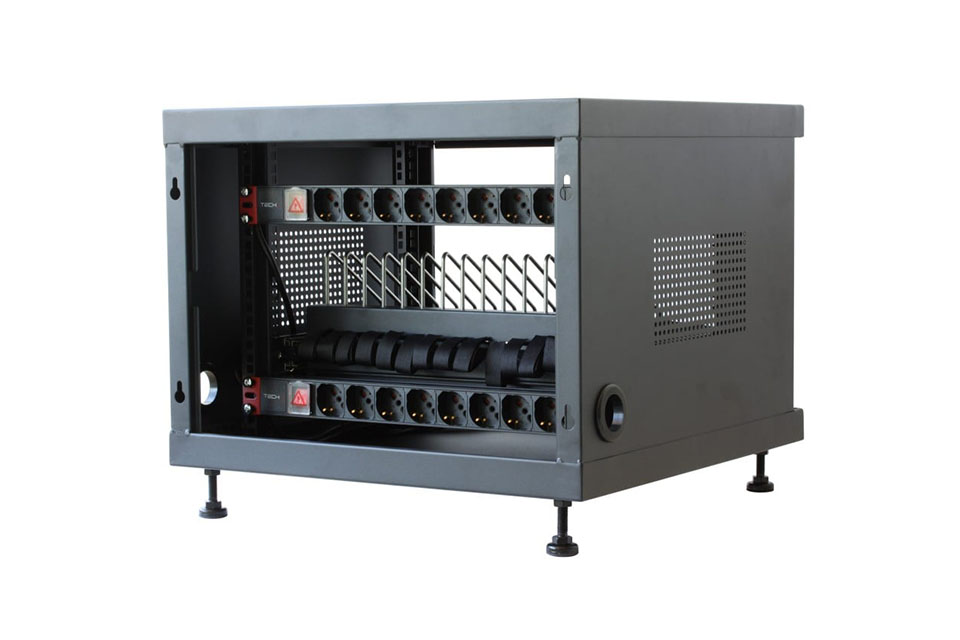
Reasons for Investment
Educational institutions are increasingly investing in charging cabinets and related infrastructure to meet the demands of modern technology use among students. Several key factors drive this investment, which are critical for enhancing the learning environment and operational efficiency.
1. Managing Device Usage
With the rise of one-to-one technology programs, schools must manage a large number of devices effectively. Charging solutions not only provide necessary power to these devices but also help IT teams maintain order by mitigating issues such as tangled cords, missing chargers, and outlet shortages. Proper charging infrastructure can streamline device management, thereby freeing up classroom space and reducing the strain on school electrical systems.
2. Enhancing Learning Participation
The availability of charged devices at home contributes to increased participation in learning activities. Schools that have successfully implemented take-home device programs report greater engagement from students and their families, as access to technology supports continuous learning outside of the classroom. This widespread access is essential for fostering a more inclusive educational experience, benefiting all students, including those with special needs.
3. Ensuring Device Accountability
Without a clear accountability framework, issues of device misuse and damage can arise, creating confusion among students and educators. Implementing secure charging solutions, along with digital or printed agreements for device usage, can help establish accountability and maintain a history of device handling. This proactive approach is essential for minimizing risks associated with device management in educational settings.
4. Addressing Economic and Operational Challenges
The investment in charging infrastructure can significantly alleviate the economic burden on schools by reducing costs related to device management and maintenance. Schools that approach technology deployment as a managed system, rather than a mere distribution of devices, consistently see better learning outcomes and lower support costs. This strategic investment includes considerations such as charger audits, firmware updates, and budgeting for device lifecycle management.
5. Promoting Security and Organization
Effective device management is crucial for protecting educational investments. Charging stations designed for educational settings not only enhance organization but also address security concerns. By investing in durable and secure charging solutions, schools can ensure that their mobile technology remains accessible and protected, fostering an environment conducive to effective learning. The adaptability of these solutions further allows institutions to customize their setups to meet diverse educational needs.

Benefits
Investing in charging cabinets for students offers a multitude of benefits that enhance both educational outcomes and operational efficiency within schools.
Improved Device Readiness
One of the primary advantages of charging cabinets is ensuring that devices, such as laptops and tablets, are always ready for use. This eliminates downtime caused by low battery issues, allowing students to engage fully in their learning activities without interruptions. When devices are charged and available, instructional time is maximized, which directly contributes to better learning outcomes.
Enhanced Security
Charging cabinets provide a secure environment for storing devices, significantly reducing the risk of loss or theft. Features such as lockable doors and durable construction make these cabinets a reliable choice for educational settings. By safeguarding valuable technology investments, schools can avoid the costs associated with replacing lost or damaged devices.
Streamlined Management
With the integration of smart technology, charging cabinets facilitate efficient management of devices. Schools can implement systems for tracking device usage, automating check-outs and returns, and maintaining accountability among students. This organized approach minimizes confusion and ensures that both staff and students understand their responsibilities regarding device care and usage.
Support for Diverse Learning Needs
Charging cabinets can be customized to meet the unique needs of different educational environments. Their adaptability allows schools to accommodate various devices and incorporate analytics for informed decision-making on resource allocation. This flexibility enhances the learning experience, ensuring that all students have access to the technology they require for their studies.
Cost-Effective Solutions
While the upfront investment in charging cabinets may seem substantial, they ultimately lead to cost savings by reducing manual labor and administrative burdens on IT teams. By automating processes related to device management, schools can optimize their operational efficiency, allowing staff to focus on educational priorities rather than logistical challenges. Moreover, a well-managed device lifecycle, facilitated by charging solutions, can prevent unexpected costs associated with repairs and replacements.

Case Studies
Manual and Automatic Search Procedures
In examining the integration of charging cabinets within educational settings, a comprehensive search procedure was conducted to locate relevant studies and literature. This process included both manual and automatic searches of various academic databases, including Science Direct, Taylor & Francis, MDPI, SAGE, Springer Link, Wiley, and IEEE Xplore. These platforms were thoroughly researched to gather a robust set of primary studies pertaining to flipped classrooms and their impact on higher education, ensuring a detailed analysis of the subject matter.
Impact on Student Learning
A study focusing on the effects of Project-Based Learning (PBL) and the Flipped Classroom Model (FCM) highlighted the educational benefits of such methodologies. Conducted in a public middle school in Mu la, Turkey, the research involved 80 sixth-grade students and compared PBL, FCM-supported PBL, and traditional teaching methods. Findings suggested that the innovative approaches significantly improved students’ academic achievement and retention of knowledge, underscoring the importance of integrating technology and student engagement strategies in contemporary education.
Student Engagement and Autonomy
The design of learning environments also plays a crucial role in student engagement. Research indicates that when students are given autonomy over their learning, it fosters a sense of belonging and encourages active participation. The implementation of charging cabinets can enhance this environment by providing students with easy access to technology, thereby promoting their engagement and satisfaction within educational settings. Furthermore, allowing students to take charge of their learning has been associated with improved academic performance and personal well-being.
Teacher Support and Collaboration
The successful integration of charging cabinets and other technologies is contingent upon the support provided to educators. Studies have shown that when teachers feel supported and included in decision-making processes regarding new technology initiatives, their attitudes towards implementation remain positive. An example of effective collaboration is seen in initiatives like the University of Oklahoma K20 Center, which brings together educators and stakeholders to discuss and decide on technology applications that best meet the needs of their students. This collaborative approach fosters a supportive atmosphere that enhances the overall educational experience.
Challenges and Considerations
The investment in charging cabinets for students comes with a variety of challenges and considerations that schools must navigate to ensure successful implementation and utilization.
Cost of Infrastructure
One of the primary challenges is the total cost of ownership (TCO) associated with medium- and heavy-duty electric vehicle (MHDEV) charging infrastructure, which can be substantial. Although the maintenance costs for electric vehicles are generally lower compared to their diesel counterparts, the initial purchase price of charging stations can exceed $100,000, depending on the installation specifics and required infrastructure upgrades. Furthermore, the fluctuating costs of electricity tariffs can affect recharging expenses, making it difficult for schools to predict and manage their budgetary allocations for charging facilities.
Maintenance and Operational Considerations
While electric vehicles tend to have lower maintenance requirements, the charging infrastructure itself still necessitates regular upkeep. Schools may need to invest in retraining existing maintenance staff or hiring specialized workers to ensure the charging cabinets function effectively. As the charging technology evolves, schools must also consider the ongoing need for technological updates and repairs to keep pace with advancements in electric vehicle technology.
Siting and Accessibility
The siting of charging stations presents additional complexities. Decisions on where to locate charging infrastructure—whether within school premises or at nearby facilities—can impact utilization rates and accessibility for students. Poor siting decisions may result from rushed installations due to public funding pressures, leading to underutilized infrastructure that does not meet the needs of the school community.
External Factors and Policy Influence
Externalities, both market and environmental, can hinder effective investment in charging infrastructure. Schools may face barriers such as R&D spillovers and environmental regulations that complicate the financing and deployment of electric vehicle charging stations. Moreover, policies aimed at promoting electric vehicle adoption may not sufficiently address the unique challenges that educational institutions face, necessitating tailored approaches to policy formulation and funding opportunities.
Uncertainty in Demand
Another significant challenge is the unpredictable demand for electric vehicle charging facilities. With relatively low adoption rates of electric vehicles among students, schools may struggle to justify the investments made in charging cabinets without a clearer understanding of future demand trends. Schools must balance the need for infrastructure with the uncertainty of how many students will utilize the charging stations.
Future Trends
As schools increasingly recognize the importance of technology in education, the investment in charging cabinets for student devices is anticipated to grow significantly. This trend is driven by several key factors, including the need for sustainable practices, enhanced educational outcomes, and community engagement.
Technological Advancements
Rapid advancements in technology are set to transform the way charging infrastructure is integrated into educational environments. Innovations such as wireless charging solutions and enhanced energy management systems can facilitate more efficient and convenient charging options for students, ensuring devices are always ready for use in the classroom. As schools adopt these new technologies, they will also enhance their curriculum by providing hands-on learning experiences in renewable energy and sustainable practices.
Sustainable Practices
The shift towards sustainability is a major trend influencing school charging infrastructure. With growing emphasis on reducing carbon footprints and promoting eco-friendly practices, schools equipped with charging cabinets contribute to this goal by facilitating the use of electric devices and encouraging the adoption of electric vehicles among staff and the community. Moreover, the integration of charging stations can position schools as community hubs, fostering engagement and promoting an environmentally responsible image.
Financial Considerations
Despite the initial investment required for charging cabinets, schools can realize long-term financial savings. Revenue generated from charging fees and participation in utility demand-response programs can help offset installation costs and create additional income streams. As financial models evolve and more schools share their success stories, it is expected that the trend of investing in charging infrastructure will gain momentum.
Community Engagement
Fostering community engagement is another driving force behind the adoption of charging cabinets in schools. By offering charging solutions, schools can become central locations for local residents with electric vehicles, thereby strengthening ties with the community and enhancing the school’s reputation as an environmentally responsible institution. This increased engagement can lead to collaborative initiatives and programs that further benefit both students and the surrounding community.




